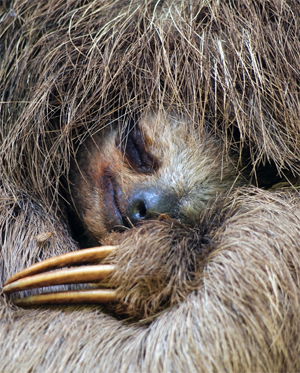When Sloth Is Not Sin
In all of God’s creation, the sloth has a unique claim to fame: the slowest mammal on the planet. Top speed? A whopping 0.15 miles per hour. Why’s he so slow? Is he the supreme symbol of slothfulness? Don’t be too quick to judge!
I remember when I encountered my first sloth at the Cincinnati Zoo. It was a rare moment of wakefulness (rare for the sloth, not me). Oh so slowly, he climbed the branch with his long, curved claws, while a sizeable—and patient—crowd of observers gathered to watch.
Upon reaching the top of the branch, his claws continued to reach upward into nothingness for quite some time, hoping to climb higher. Finally he oh so slowly paused, turned around, and began oozing back down the branch.
I had never seen an animal move so slowly, and I began to wonder—why did God make the sloth so . . . slothful?

© Vilainecrevette | Dreamstime.com
Sloths spend a lot of time sleeping. And even when they are awake, they are equipped in many other ways to conserve energy.
Slow and Steady
As it turns out, the name “sloth” is a bit of a misnomer. Sloth is defined as “habitual disinclination to exertion; indolence; laziness.” In Scripture, this sin is repeatedly warned against, especially in the book of Proverbs. But in the case of the sloth, slowness does not equal laziness. In fact, the sloth’s remarkable adaptations—including the metabolism that has made it the slowest living mammal—are necessary for its survival.
Sloths live in the tropical jungles of South America, where they spend their lives almost exclusively in the treetop area called the canopy, living on tree leaves. Leaves, as you can probably imagine, don’t provide much nutrition. You would think that sloths would need to spend their entire waking lives eating just to sustain themselves. That’s what Chinese pandas must do, munching all day long on bamboo. But here is where we begin to see the genius of the sloth’s Designer.
The Ultimate Conservationist
That famous super-slow metabolism is a wonderful conserver of energy. Sloths spend a lot of time asleep, and most of their waking time they just hang there. Even when they do move, as I observed that day at the zoo, they move very slowly. Because of this lack of activity, they require much less food than other mammals.
Furthermore, sloths have about half the muscle mass that other mammals of similar size have, and since muscle requires a great deal of nutrition to maintain, this too helps to conserve energy. This also means that sloths weigh less than you would expect by looking at them—ten pounds (4.5 kg) is about average—so they are better able to get around on high tree branches that might bend or break under more weight.
Almost like a reptile, a sloth can warm itself in the sun and cool itself in the shade.
Sloths also conserve precious energy by regulating their body temperature, which is about 10°F lower than other medium-sized mammals. Almost like a reptile, a sloth can warm itself in the sun and cool itself in the shade.
Even their digestion is specially adapted to conserve energy. Sloths have large, chambered stomachs that contain symbiotic bacteria to help break down the tough leaves. The digestion of a batch of leaves takes a month to complete. Imagine eating Thanksgiving dinner and finally digesting it by Christmas!
Hanging Out

© Hugoht | Dreamstime.com
Since sloths spend most of their time hanging upside down, a sloth’s fur grows “up” toward its head, which is opposite of other mammals.
Sloths are ideally adapted to a treetop life in other ways too. Their long, strong, curved claws allow them to hang onto branches without exertion. Sloths, like bats, will sometimes remain hanging upside down even after they die.
One of the most remarkable features of sloths is their fur. In other mammals, fur slopes toward the tail—take a look at your dog or cat, for example. You usually pet them from the front backward so that their hair doesn’t stand up. But a sloth’s fur grows “up” toward its head. Of course for a sloth, this is an advantage, since it spends most of its time hanging upside down. Up is down. This reversed hair direction, plus another thick inner coat of hair, keeps rainwater and bugs off its skin.
Although its fur is naturally dark to light brown, the thick, grooved hairs usually fill with algae, giving the sloth a nice greenish tinge that provides excellent camouflage. And the wonders don’t stop there. The algae in the sloth’s fur is a food source for beetles and a particular species of moth, colloquially known as the “sloth moth,” that relies on the sloth for its survival. A wild sloth can have hundreds of beetles and moths living in its fur at any given time, making sloth fur its own little ecosystem. And while this probably strikes most of us as somewhat revolting, it can also be viewed as another remarkable example of the Creator’s ingenious provision for various creatures.
At first glance, the slow, gentle sloth might seem like an oddity, and it is indeed one of the most unusual mammals in creation. But its remarkable design has enabled the sloth to survive. Despite all the changes in environment since the Flood and mankind’s destructiveness, many sloth species are thriving. Far from being slothful in the biblical sense, the sloth is a model of efficiency and a perfect example of God’s provision for all of His unique creatures.
Did You Know?
- The famed “giant” ground sloths are now extinct. One extinct sloth, Megatherium, was as large as an African elephant and stood about twenty feet (6 m) on its hind legs.
- All sloths have three toes on their back feet. Two-toed sloths have two “fingers” on their front feet, and three-toed sloths have three.
- Three-toed sloths have specialized “tastes” in tree leaves, which vary from sloth to sloth, and are determined by the bacteria in the sloth’s stomach. The preference is passed down as the mother feeds the baby regurgitated leaves.
- While a group of bears is called a sloth, a group of sloths is called a bed. But don’t expect to find them in groups very often; sloths are solitary creatures.
- Most mammals, even long-necked giraffes, have seven neck bones, called vertebrae. Sloths are one of the rare exceptions: two-toed sloths have six vertebrae, and three-toed sloths have nine, giving the latter the ability to turn their heads almost 360°.
- Sloths relieve themselves once a week, at the base of their “home” tree, sometimes as much as two pounds (1 kg) at a time.
CLASS: Mammalia
ORDER: Pilosa
FAMILY: Megalonychidae (two-toed sloth) and Bradypodidae (three-toed sloth)
SIZE: 24–30 in (60–80 cm) weighing 8–17 lbs (4–8 kg)
DIET: Mostly buds, tender shoots, and leaves. But some two-toed sloths have been documented as eating insects, small reptiles, and even birds!
HABITAT: Tropical rainforest of South and Central America
Answers Magazine
October – December 2011
Answers magazine has decided to do some myth-busting. This issue will examine some of the most popular myths about the dinosaurs and how they died. Along the way, you’ll learn some other cool facts about these amazing creatures—quick, can you name the smallest kind of dinosaur? We will also examine some serious contemporary issues, such as the increase of biblical compromise in homeschool materials and the dangers of the new leader in “theistic evolution,” known as the BioLogos Foundation.
Browse IssueRecommended Resources

Answers in Genesis is an apologetics ministry, dedicated to helping Christians defend their faith and proclaim the good news of Jesus Christ.
- Customer Service 800.778.3390
- Available Monday–Friday | 9 AM–5 PM ET
- © 2025 Answers in Genesis




